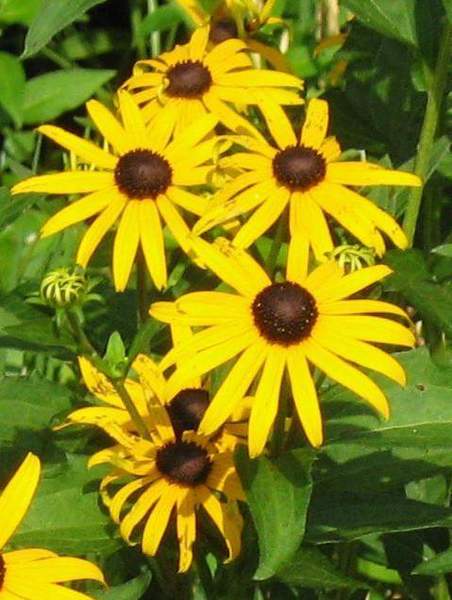Gold is a popular color that has it's tradesmark on the best of the best. From gold medals at the olympics to golden wedding bands. Gold is a just the symbolism of excellence and that rings no truer than the gold blooms of rudbeckia goldsturm. This summer beauty is long blooming, easy to care for, and long lived.
In early spring the clumps of goldsturm rudbeckia start perking up from their winter slumber; as the purple leaves turn back to a rich green. Slowly, but surely, they begin to send up blooming stalks in late spring. By the middle of June they are robust with many yellow daisy shaped flowers perched a top sturdy stems. This blooming display persists for many weeks. During this season butterflies, moths, and bees flit and buzz about them. As the summer winds down the flowers fade and dark seed-heads remain for the songbirds. Popular songbirds that frequent these are goldfinches, cardinals, and chickadees. If the seed heads are left in the garden the birds will snack on them until next spring.
Like most native perennials, rudbeckias, are very easy plants to grow and care for. They require a well-drained soil, love a little organic matter, and will flourish throughout periods of drought. When first planting incorporate about 2" of organic matter like worm castings or compost into the top six inches of soil using a fork or shovel. Then, transplant the plants making sure not to cover the crown(place where root meats the foliage). After transplanting, water plants thoroughly and monitor for wilting within the first week; water if wilted. When, the plants strike roots you can allow the soil to dry 2" down before watering again; if needed at all. This will help the plants root deeper for better drought tolerance. The yearly care is trimming back the flowering heads when desired and fertilizing in late winter or early spring with an all purpose feed. We typically use 1 part feather meal, 1 part bone meal, and 1 part kelp meal and scratch it around the plants in early spring.
Rudbeckia clumps will persist for many years in the garden and will slowly creep by underground rhizomes to increase the planting. To divide take a border or regular pitch fork and push into the ground around the plants to loosen the soil. Pull out the plants with your hands leaving an eight to ten inch spacing between mature plants. If the plants spread outside of their desired premises then the same application with a fork or shovel make it easier to remove them. The best time of year to do this is in September or early October in the south. You can save the plants removed and create a new planting.
Add this gold standard favorite to your garden and enjoy the blooms for years to come!


